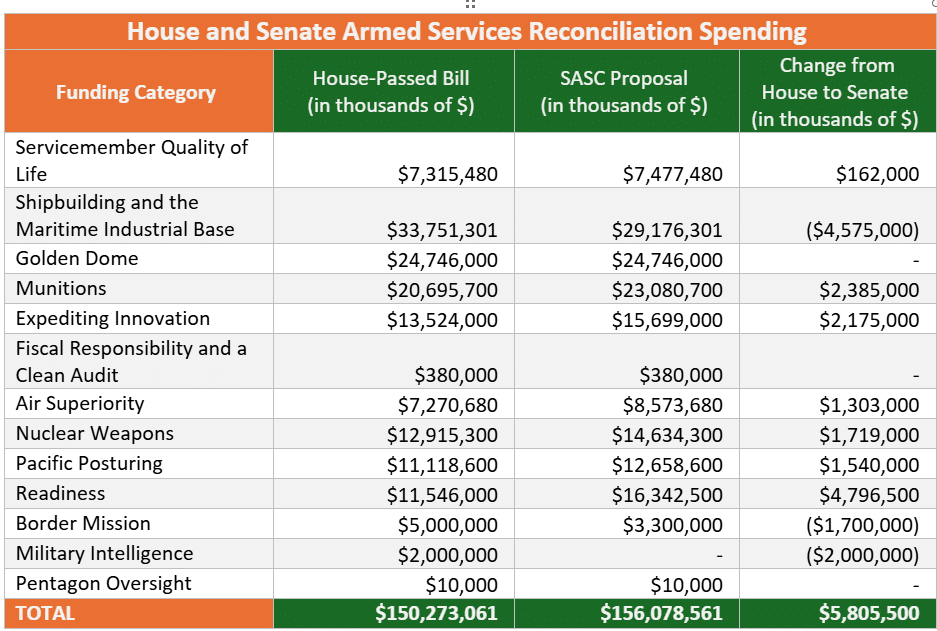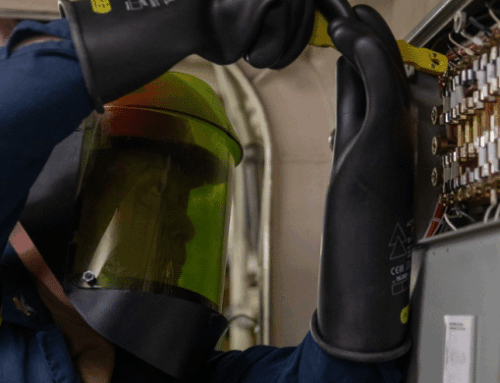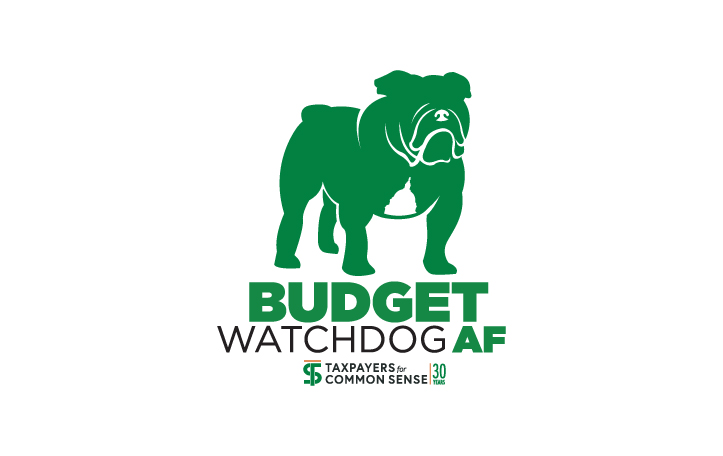The Senate Armed Services Committee (SASC) released proposed bill text on Tuesday for its portion of the budget reconciliation bill. Unlike its counterpart in the House, however, SASC has no plans to mark up the proposed language in committee (nor do most other Senate committees), opting instead to skip that tedious nod to representative democracy to expedite the process. Congressional Republicans are aiming to send a final reconciliation package to the president's desk by July 4, and this self-imposed deadline means there's simply no time for antiquated traditions like public debate and amendments.
In its proposed bill text, SASC added even more funds for the Pentagon than the House-passed bill. Click here to download our full breakdown of House-passed and SASC-proposed reconciliation funding in the Armed Services Committees' portions of the reconciliation bill.

As the table above shows, the SASC proposal includes over $5.8 billion more for national security spending in the Armed Services Committee jurisdiction than the House-passed bill, bringing total spending in this portion of the bill to over $156 billion. The bulk of the increase was put toward munitions, expediting innovation, and readiness, though air superiority, nuclear weapons, pacific posturing, and servicemember quality of life all received relative increases too.
Notably, SASC added an additional $1 billion "for risk reduction activities for the Sentinel intercontinental ballistic missile (ICBM) program," bringing the Senate total for this line item to $2.5 billion. As a reminder, this is the program that ran 37 percent overbudget at the beginning of 2024, and then 81 percent overbudget when the Air Force certified the program to move forward last July. These "risk reduction activities" could more accurately be called "paying for things we didn't think about when we insisted this was the only viable, cost-effective option for maintaining the land-based leg of the nuclear triad," though that's admittedly a mouthful. News broke in May that the program will need to dig entirely new silos for these missiles rather than refurbishing the Minuteman III silos as originally planned.
Under the "expediting innovation" category, SASC added over $2 billion to the House's $13.5 billion. Looking at the individual line items in this category, they bore a striking resemblance to some of the congressional Pentagon budget increases we've been reporting on in the regular appropriations process (if a full-year continuing resolution can be called "regular").
For instance, both the House-passed bill and the SASC proposal include $50 million "for the development, procurement, and integration of high-altitude stratospheric balloons for military use." The full-year CR included $14.5 million for "stratospheric balloon constellation experimentation." The reconciliation proposals also include $750 million "for the acceleration of development of small, portable modular nuclear reactors for military use," while the full-year CR included $6 million for "expeditionary portable fission generators." Neither of these projects were included in the Pentagon's FY2025 budget request.
In other words, the "expediting innovation" section of reconciliation, and likely other sections as well, is partly about giving lawmakers another chance to fund pet projects that the Pentagon didn't request. As we've reported, these program increases allow lawmakers to effectively earmark funds to the benefit of their states, districts, and campaign contributors. By shoving them into reconciliation, a process that was meant to balance the budget rather than increase the deficit with new spending, lawmakers have managed to hit a new low when it comes to transparency over program increases in the Pentagon budget. We honestly didn't think that was possible.
Alongside the full text of its proposal, SASC also released a summary. Notably, it's titled "SASC/HASC Defense Reconciliation Overview," and it includes both the HASC and SASC logos, offering at least some hint that HASC is onboard with SASC's even loftier topline—so best not to hold your breath for the House pushing back on the extra $5.8 billion in the Senate package.
Perhaps the only good news in the Senate package is the modest increase for servicemember quality of life, though it appears far more modest than the $9 billion total claimed on the summary page. Adding up the line items, funding for this category totals just under $7.5 billion in the SASC package, up from $7.3 billion in the House-passed bill.
Stepping back from the particulars, it bears repeating that the Pentagon does not need more money. With a current budget of roughly $850 billion (a nearly 50 percent increase adjusting for inflation since the turn of the century), what it really needs is some spending discipline and strategic prioritization. But even if you support increasing Pentagon spending, reconciliation is the wrong place to do it. Reconciliation is supposed to be a tool for balancing the budget, but it's become a partisan battering ram for pushing political agendas through Congress with a simple majority. Ramming an extra $156 billion for the Pentagon into reconciliation also undermines the long-standing practice of bipartisan collaboration and compromise on national security spending. In short, this is a truly terrible way to budget for national security.









